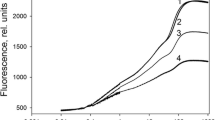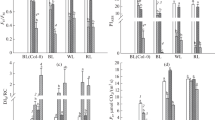Abstract
When dark-grown aurea mutant tomato seedlings which lack more than 95% of the phytochrome present in isogenic wild-type seedlings are kept in white or blue light, four nuclear-encoded transcripts coding for plastidic proteins (the light-harvesting chlorophyll a/b-binding protein of photosystem I and II [cab-PSII], plastocyanin and subunit 2 of photosystem I) are present in comparable amounts. These transcript levels in red light are strongly reduced in aurea seedlings when compared with those of wild type. Thus, blue light is required for normal expression of these genes in the mutant, while red light alone is not sufficient. Red light-grown aurea seedlings are very sensitive to blue light, even 10 minutes of blue light every day suffices to cause a measurable increase in cab-PSII transcript level. The action of blue light on the expression of cab-PSII in the mutant is under phytochrome control. After 8 days of blue light, phytochrome is almost as effective in inducing cab-PSII mRNA as in the isogenic wild type, whereas after 8 days of red light, only a small phytochrome response was observed in the mutant. It is concluded that blue light sensitizes the mutant to the residual phytochrome which allows normal gene expression and survival of the mutant under daylight conditions.
Similar content being viewed by others
Abbreviations
- BL:
-
blue light
- cab:
-
chlorophyll a/b-binding protein
- Chl:
-
chlorophyll
- FR:
-
far-red light
- PSI:
-
photosystem I
- PSI-2:
-
subunit 2 of photosystem I
- PSII:
-
photosystem II
- RL:
-
red light
- WL:
-
white light
References
Adamse P, Kendrick RE, Koornneef M: Photomorphogenetic mutants of higher plants. Photochem Photobiol 48: 833–841 (1988).
Adamse P, Jaspers PAPM, Bakker JA, Wesselius JC, Heeringa GH, Kendrick RE, Koornneef M: Photophysiology of a tomato mutant deficient in labile phytochrome. J Plant Physiol 133: 436–440 (1988).
Bruce WB, Christensen AH, Klein T, Fromm M, Quail PH: Photoregulation of a phytochrome gene promoter from oat transferred into rice by particle bombardment. Proc Natl Acad Sci USA 86: 9692–9696 (1989).
Chappell J, Hahlbrock K: Transcription of plant defense genes in response to UV or fungal elicitor. Nature 311: 76–78 (1984).
Fluhr R, Chua N-H: Developmental regulation of two genes encoding ribulose-bisphosphate carboxylase small subunit in pea and transgenic petunia plants: phytochrome response and blue light induction. Proc Natl Acad Sci USA 83: 2358–2362 (1986).
Hoffman NE, Pichersky E, Malik VS, Castresana C, Ko K, Darr SC, Cashmore AR: A cDNA clone encoding a photosystem I protein with homology to photosystem II chlorophyll a/b-binding polypeptides. Proc Natl Acad Sci USA 84: 8844–8848 (1987).
Hoffman NE, Pichersky E, Malik VS, Ko K, Cashmore AR: Isolation and sequence of a tomato cDNA clone encoding subunit II of the photosystem I reaction center. Plant Mol Biol 10: 435–445 (1988).
Kaufman LS, Thompson WF, Briggs WR: Phytochrome-induced accumulation of RNA encoding the small subunit of RuBPCase requires ten thousand fold more red light than does the RNA for the chlorophyll a/b binding protein. Science 226: 1447–1449 (1984).
Ken-Dror S, Horwitz BA: Altered phytochrome regulation of greening in an aurea mutant of tomato. Plant Physiol 92: 1004–1008 (1990).
Koornneef M, Cone JW, Dekens RG, O'Herne-Robers EG, Spruit CJP, Kendrick RE: Photomorphogenetic responses of long hypocotyl mutants of tomato. J Plant Physiol 120: 153–165 (1985).
Kronenberg GHM, Kendrick RE: Phytochrome: the physiology of action. In: Kendrick RE, Kronenberg GHM (eds) Photomorphogenesis in Plants, pp. 547–564. Martinus Nijhoff, Dordrecht (1986).
Lopez-Juez E, Nagatani A, Buurmeijer WF, Peters JL, Furuja M, Kendrick RE, Wesselius JC: Response of light-grown wild-type and aurea-mutant tomato plants to end-of-day far-red light. J Photochem Photobiol 4: 391–405 (1990).
Marrs KA, Kaufman LS: Blue-light regulation of transcription for nuclear genes in pea. Proc Natl Acad Sci USA 86: 4492–4495 (1989).
Mohr H: Coaction between pigment systems. In: Kendrick RE, Kronenberg GHM (eds) Photomorphogenesis in Plants, pp. 547–564. Martinus Nijhoff, Dordrecht (1986).
Oelmüller R, Briggs WR: Intact plastids are required for nitrate- and light-induced accumulation of nitrate reductase activity and mRNA in squash cotyledons. Plant Physiol 92: 434–439 (1990).
Oelmüller R, Mohr H: Mode of coaction between blue/UV light and light absorbed by phytochrome in light-mediated anthocyanin formation in the milo (Sorghum vulgare Pers.) seedling. Proc Natl Acad Sci USA 82: 6124–6128 (1985).
Oelmüller R, Kendrick RE, Briggs WR: Blue-light mediated accumulation of nuclear-encoded transcripts coding for proteins of the thylakoid membrane is absent in the phytochrome-deficient aurea mutant of tomato. Plant Mol Biol 13: 223–232 (1989).
Parks BM, Jones AM, Adamse P, Koornneef M, Kendrick RE, Quail PH: The aurea mutant of tomato is deficient in spectrophotometrically and immunochemically detectable phytochrome. Plant Mol Biol 9: 97–107 (1987).
Pichersky E, Bernatzky R, Tanksley SD, Breidenbach RB, Kausch AP, Cashmore AR: Molecular characterization and genetic mapping of two clusters of genes encoding chlorophyll a/b-binding proteins in Lycopersicon esculentum (tomato). Gene 40: 247–258 (1985).
Sharrock RA, Parks BM, Koornneef M, Quail PH: Molecular analysis of the phytochrome deficiency in an aurea mutant of tomato. Mol Gen Genet 213: 9–14 (1988).
Silverthorne J, Tobin EM: Demonstration of transcriptional regulation of specific genes by phytochrome action. Proc Natl Acad Sci USA 81: 1112–1116 (1984).
Author information
Authors and Affiliations
Rights and permissions
About this article
Cite this article
Oelmüller, R., Kendrick, R.E. Blue light is required for survival of the tomato phytochrome-deficient aurea mutant and the expression of four nuclear genes coding for plastidic proteins. Plant Mol Biol 16, 293–299 (1991). https://doi.org/10.1007/BF00020560
Received:
Accepted:
Issue Date:
DOI: https://doi.org/10.1007/BF00020560




